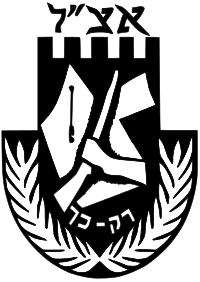
Back Irgun Zwai Leumi ALS إرجون (منظمة عسكرية) Arabic ارجون (اسرائيل) ARZ İrqun Azerbaijani Иргун Bulgarian Irgun Catalan Irgun Czech Irgwn Welsh Irgun Danish Irgun Zwai Leumi German
| National Military Organization | |
|---|---|
| Hebrew: הארגון הצבאי הלאומי | |
 Irgun emblem. The map shows both Mandatory Palestine and the Emirate of Transjordan, which the Irgun claimed in its entirety for a future Jewish state. The acronym "Etzel" is written above the map, and "raq kach" ("only thus") is written below. | |
| Leader | Notable: Ze'ev Jabotinsky, Avraham Tehomi, Menachem Begin |
| Dates of operation | 1931–1949 |
| Dissolved | 12 January 1949 |
| Split from | Haganah |
| Merged into | Israel Defense Forces |
| Country | Mandatory Palestine Israel |
| Allegiance | Yishuv |
| Ideology | Revisionist Zionism Anti-Arab sentiment Anti-British sentiment |
| Notable attacks | Haifa police headquarters bombing Black Sunday King David Hotel bombing 1946 British Embassy bombing Deir Yassin massacre The Sergeants affair |
| Status | Paramilitary |
| Part of | Jewish Resistance Movement |
| Battles and wars | Arab Revolt in Palestine World War II Jewish Revolt in Palestine |
The Irgun (Hebrew: ארגון), officially the National Military Organization in the Land of Israel (Hebrew: הארגון הצבאי הלאומי בארץ ישראל, romanized: HaIrgun HaTzvaʾi Ha-Leumi b-Eretz Israel; abbr. אצ״ל, romanized: Etzel or IZL), was a Zionist paramilitary organization that operated in Mandatory Palestine between 1931 and 1948. It was an offshoot of the older and larger Jewish paramilitary organization Haganah.[1] The Irgun has been viewed as a terrorist organization or organization which carried out terrorist acts.[2][3][4][5]
The Irgun policy was based on what was then called Revisionist Zionism founded by Ze'ev Jabotinsky.[6] Two of the most infamous operations for which the Irgun were known; the bombing of the King David Hotel in Jerusalem on 22 July 1946 and the Deir Yassin massacre that killed at least 107 Palestinian Arab villagers, including women and children, carried out together with Lehi on 9 April 1948.
The organization committed acts of terrorism against Palestinian Arabs, as well as against the British authorities, who were regarded as illegal occupiers.[7] In particular the Irgun was described as a terrorist organization by the United Nations, British, and United States governments; in media such as The New York Times newspaper;[8][9] as well as by the Anglo-American Committee of Inquiry,[10][11] the 1946 Zionist Congress[12] and the Jewish Agency.[13] Albert Einstein, in a letter to The New York Times in 1948, compared Irgun and its successor Herut party to "Nazi and Fascist parties" and described it as a "terrorist, right wing, chauvinist organization".[14]
Following the establishment of the State of Israel during the 1948 Palestine war, the Irgun began to be absorbed into the newly created Israel Defense Forces. Conflict between the Irgun and the IDF escalated into the 1948 Altalena affair, and the Irgun formally disbanded on January 12, 1949. The Irgun was a political predecessor to Israel's right-wing Herut (or "Freedom") party, which led to today's Likud party.[15] Likud has led or been part of most Israeli governments since 1977.
- ^ Jacob Shavit, Jabotinsky and the Revisionist Movement 1925–1948 p. 97 Routledge 1988 ISBN 978-0-7146-3325-1
- ^ Cite error: The named reference
SshmidtFCPRIOTwas invoked but never defined (see the help page). - ^ Bell, J. Bowyer (1979). Terror out of Zion : Irgun Zvai Leumi, LEHI, and the Palestine underground, 1929-1949. Dublin: Academy Press. ISBN 978-0-906187-11-1.
- ^ Whittaker, David (2012). The Terrorism Reader (4th ed.). Routledge. p. 29. ISBN 978-0415687317.
- ^ Kushner, Harvey W. (2002). Encyclopedia of Terrorism. Thousand Oaks: SAGE Publications. p. 181. ISBN 145226550X.
- ^ Howard Sachar: A History of Israel: From the Rise of Zionism to Our Time, pp. 265–266
- ^ "Irgun Zvai Leumi | Jewish right-wing underground movement". Encyclopædia Britannica. Retrieved 2016-01-02.
- ^ Pope Brewer, Sam. Irgun Bomb Kills 11 Arabs, 2 Britons. New York Times. December 30, 1947.
- ^ Irgun's Hand Seen in Alps Rail Blast. New York Times. August 16, 1947.
- ^ W. Khalidi, 1971, 'From Haven to Conquest', p. 598
- ^ Terry, Janice (2008). Encyclopedia of world history Vol 5 pg 20. Infobase Publishing.
- ^ "Jewish Terrorism and Jewish Resistance". The Jewish Plan for Palestine—Memoranda and Statements presented by The Jewish Agency for Palestine to the United Nations Special Committee on Palestine. The Jewish Agency for Palestine, Jerusalem. 1947. pp. 20–26.
- ^ "Major Political Developments". The Jewish Plan for Palestine—Memoranda and Statements presented by The Jewish Agency for Palestine to the United Nations Special Committee on Palestine. The Jewish Agency for Palestine, Jerusalem. 1947. p. 32.
- ^ Einstein, Albert (2007). Rowe, David E. (ed.). Einstein on Politics: His Private Thoughts and Public Stands on Nationalism, Zionism, War, Peace, and the Bomb. Princeton University Press. p. 350. ISBN 9780691120942.
- ^ Eisenstadt, S.N. (1985). The Transformation of Israeli Society. London: Weidenfeld and Nicolson. pp. 173–174. ISBN 0-297-78423-4.
One of the main developments in the initial period of the State was the growth of the Herut party.... It developed from the older Revisionist groups, the 'terrorist' groups of the Irgun Zvai Leumi and members of the Revisionist party ... in 1965 Herut founded, together with the great part of the Liberals, a parliamentary bloc ... in 1973, with the addition of other small groups, it became transformed into Likud